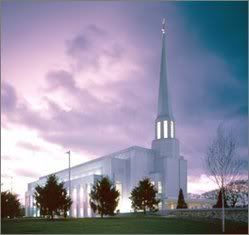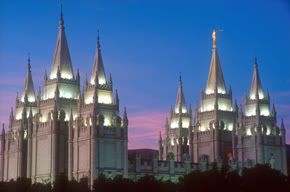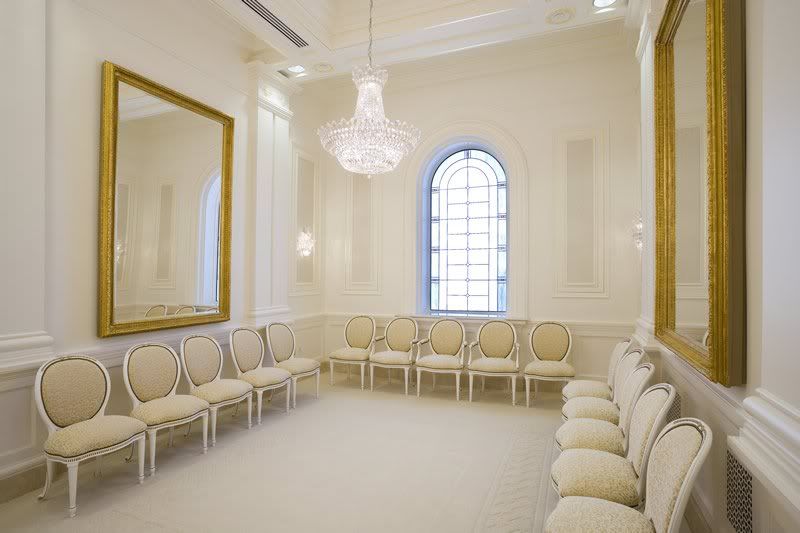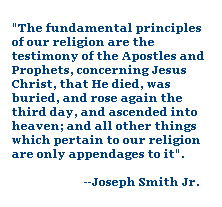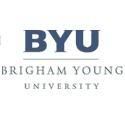Priesthood, Covenants, and Temple
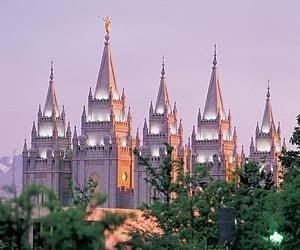 Some Christians question the LDS Church for out belief that God has restored the Old Testament (OT) Levitical or Aaronic Priesthood and covenant. Our critics are correct in pointing out that the Bible teaches that the OT Levitical covenant and priesthood was fulfilled and changed because we see that the outward rites and ordinances associated with the covenant and priesthood were abolished and not continued in the NT church. So if this is true, how is it that the LDS has an Aaronic Priesthood?
Some Christians question the LDS Church for out belief that God has restored the Old Testament (OT) Levitical or Aaronic Priesthood and covenant. Our critics are correct in pointing out that the Bible teaches that the OT Levitical covenant and priesthood was fulfilled and changed because we see that the outward rites and ordinances associated with the covenant and priesthood were abolished and not continued in the NT church. So if this is true, how is it that the LDS has an Aaronic Priesthood?
John the Baptist appeared to Joseph Smith and conferred the Aaronic Priesthood on him by the laying on of hands months before Peter James and John conferred the Melchezidek priethood and the authority of the Apostleship. John the Baptist specifically told Joseph Smith that he acted under the direction and authority of Peter James and John.
The LDS church does claim a restoration of the Levitical and Aaronic Priesthood but not a restoration of the Levitical commandments of the Law of Moses. The Levitical is considered to be an appendage, part or subset of the Aaronic and the Aaronic being an appendage of the Melchizedek now as it exists in it's current form. That said, the LDS Church does not claim a restoration of the OT commandments, ritual or requirements associated with the OT version of the Aaronic priesthood. The OT commandments and requirements of the priesthood were annulled, fulfilled, canceled, voided etc. Remember that while God says the Aaronic Priesthood is everlasting, Paul says it is a changeable priesthood. But being changeable doesn't mean the priesthood would stop being everlasting. What Paul says in Heb 7:18 would be canceled or annulled is the commandments associated with the priesthood but not the purpose, covenant or priesthood itself.
Now many here rightly point out that priesthood is all about offering sacrifice. And that is exactly what the priesthood is about today. However, since the requirements of the priesthood have changed no one offers animal sacrifice but the body and blood of Christ's infinite and last sacrifice. And those of the church offer a broken heart and contrite spirit and their whole souls in consecration to God. And like the OT Priests the Bishop judges ritual purity to determine if a person is worthy to offer sacrifice and participate in ordinances of sacrifice.
The Bishop has no official duty to preach the word necessarily. That is why when you attend an LDS sacrament meeting, the sermons and Sunday School lessons are given by the membership. For the preacher is no better than the listener. And the membership has primary responsibility to shepherd and care for one another. And that is why membership visit one another through the program of home and visiting teaching. The responsibility of the Bishop is to offer the communion of the Lord's Supper and to determine ritual purity to participate in and receive this and other rites and offerings of covenant sacrifice.
Is there is evidence that a division of responsibility existed in the NT church? Yes there is. You will remember that despite there being a priesthood of all believers male membership was called to be either deacons or presbyters who acted under the direction and keys of the bishop. The Bible makes a clear distinction between responsibility and authority of deacons and presbyters. James says that the sick were to call upon the Presbyters for an anointing and blessing and Paul says to Timothy that he should neglect not his gift (referring to the gift of the Holy Ghost or baptism of fire) which was given by the laying on of hands by the presbytery. And we should remember that John the baptist whose authority parallels the Aaronic authority had responsibility for water baptism but john said he did not have authority to baptize with fire and the Holy Ghost.
So we see here a distinction in the NT church and everlasting covenant where deacons were likely given authority to administer baptism and assist in the administration of the Lords Supper both of which are rites involved with the reception and continual renewal of justification and the remission of sins, while the higher division of the presbytery had authority over sanctifying ordinances of the baptism of fire and in the restored Melchizedek Priesthood Christian temple and the everlasting "sealing in the forehead" covenant of complete consecration to God.
Some claim that there is no need for the OT temple any more . However most all Christians accept that the Bible prophesies the literal rebuilding of the temple. Isaiah 2, Micah 2, Dan 2 and Ezekiel 37 all talk about that the sanctuary, tabernacle, or mountain of the Lord will be among Israel and God will establish his everlasting covenant to sanctify Israel. And what about Johns words when the angels ask who all the people were who were dressed in white robes and the answer says that these are they who cane out of the tribulation and have washed their robes white in the blood of the lamb and serve in the temple.
It is true that eventually there will be no temple as John foresees because the whole earth and all those on it will become fully sanctified. Remember what Ezekiel says about the purpose of the temple is for sanctification. It provides an eternal pattern and celestial perspective. The idea of the temple is scalable that begins with the soul and then a building, then temple city, holy nation, then celestial earth. And when the stone cut out of the mountain in Daniels dream becomes a mountain (temple) and fills the whole earth, then finally there will be no more need for a place set aside as holy for God because when the Earth becomes part of heaven, everywhere and everyone on it will be holy.
Remember that Paul criticized the law of Moses and Levitical priesthood and covenant because it didn't make anything perfect or sanctified. The law just reminded You that you had to continually repent and offer animal sacrifice to be justified for sin. But through the transformative power and grace of Christs spirit and atonement, the higher covenant promises sanctification and perfection. And the temple is given by God to administer this everlasting covenant of sanctification or "sealing in the forehead" until the whole Earth is sanctified and Christ saves us from our sins and not just in our sins.
Many Christians claim that they do not recognize the operation of the priesthood in the NT because priesthood is all about sacrifice and they do not see sacrifice in the NT. While there may not be any animal sacrifice in the NT, the whole NT is all about sacrifice. Here we see the NT saints giving all they have in consecration and setting it at the feet of the Bishop in the United Order. And we see the Christian martyrs making the ultimate sacrifice by giving their very lives for their testimony of Jesus Christ and His gospel. The message of NT is all about sacrifice and therefore it is all about priesthood.
In the OT the Aaronic priest made judgments in the name of the Lord about who was clean and able to make animal sacrifice in the temple. In the NT, the bishop served as a priest to judge ritual purity of the Saints to participate in the covenant sacrificial rites such as who is worthy to receive the communion of the Lord's Supper.
While God says the Aaronic priesthood is everlasting, In the NT Paul says the commandments and requirements of the Aaronic priesthood and covenant had been annulled, canceled, and changed. Jesus Christ said the Law of Moses and animal sacrifice was fill filled. But the purpose of the covenant, the blessings of the covenant, and the principle of sacrifice are the same. Christ has taught that the only acceptable sacrifice is our whole will and a broken heart and contrite spirit to God. While the changeable covenant and priesthood justifies, cleanses us from sin; it reminds us that we need the higher everlasting and unchangeable covenant of sanctification to be perfected as Christ has commanded us.
The everlasting covenant is the complete consecration of our hearts and minds and all we are to God. The covenant of perfection was given by Christ when the rich young man had said he had observed the Law of Moses from his youth. In response the Savior invited the young man to sell all that he possessed and come and follow Him. This is the everlasting and sanctifying covenant after the order of the unchangeable Melchizedek priesthood.
Some question why tithing is required for an LDS member to enter the temple. It this a form of coercion? The Bishop, as a high priest offers the flesh and blood of Christs infinite and last sacrifice. And the Bishop as a high priest has responsibility to determine ritual purity. Tithing is one requirement of ritual purity to enter the Melchizedek priesthood temple and receive the everlasting covenant of sanctification. Now why would it make sense to want to make a covenant with God of 100% devotion and consecration when you can't even part with 10%.
But there is also a deeper significance here. And that is giving the person who pays a full tithe a hope of a future complete sanctification from all sin and perfection in all righteousness. And that hope springs from the realization that while there may be many commandments we are not sanctified in, after being declared a full tithe payer by the Bishop who serves as a judge in Israel in the name of the Lord, I know that I have been perfected and sanctified in keeping that commandment. And through this process ,the everlasting temple covenant, and the transformative power and grace of the Holy Ghost and Christs atonement,Christ will sanctify and perfect me in all things.
The bread and water cup of the Holy Communion of the Lord's Supper parallel the sacrificial rites done in the OT temple. But the message, covenant, and blessing of the OT temple and the emblems of the Lords Supper is that we are sinners, and we continually need the justification of Christ for remission of sins. But the key here was that the lesser covenant points us towards the need for sanctification and perfection in Christ through the higher covenant.
The Temple covenant today is a promise of sanctification and does not just carry the same message of justification as the OT temple. The higher and everlasting temple covenant promises us complete sanctification and perfection in righteousness. Not just that we are called clean by the grace and mercy of Christ, but clean in very being through the transformative power after Christ's Spirit. The higher covenant is that Christ will save us from our sins and not in our sins.
The teaching of the fall was that man became sinful. An angel was placed before the tree of life so Adam couldn't partake of the tree and live forever in his sins. Even though Adam was sorry for his transgressions and sins and accepted Christ who was speaking to him, he couldn't just go ahead and eat the fruit of the Tree of Life again and live forever because Adam was still sinful. And although his acceptance of Christ made it possible for Christ to still talk to Adam after sinning; by justification, Adam still needed to live 1000 years before he had become sanctified and perfected in righteousness by the power and transformative grace of Christ such that he was ready to partake of the tree of life again, ready to stand before the Father and dwell in the Celestial Kingdom.
The higher covenant and promise is that Christ really has the power to fully sanctify a perfect man "in this world." That is right. In LDS theology man will be perfected and sanctified by Christ in this world before being admitted into the presence of the Father. This is the new model for the new temple. We cannot enter the presence of the Father without first being sanctified and perfected by Christ here "in this world". It took Adam 1000 years and it will take us the rest of the Millennium but at the end Jesus Christ will yield up His work unto the Father.
Do you not believe that the grace and power of Christ can overcome, perfect and sanctify our sinful natures and the flesh in this world? I say yes for all things are possible with God. The flesh will be changed from corruptible to incorruptible, flesh and blood will become flesh and bone, but as Job said, “yet in my flesh shall I see God” (Philip. 3: 21, 1 Cor. 15: 51-52, Job 19: 26).
When we compare the OT covenants with the NT covenant, we see the first and most important covenant is the covenant of obedience. Obedience involves accepting all those things God has asked us not to do. The next covenant is Sacrifice, which involves all those commandments God has asked His people to do. We know that obedience is better than sacrifice because Samuel tells Saul “And Samuel said, Hath the Lord as great delight in burnt offerings and sacrifices, as in obeying the voice of the Lord? Behold, to obey is better than sacrifice, and to hearken than the fat of rams” (1 Sam. 15: 22). To break the law of obedience is considered a sin of commission. To break the law of sacrifice is considered a sin of ommission.
Now that all have sinned who have reached the age of accountability because "where there is no law, sin in not imputed.” But Paul reminds us that even the Gentiles can sin, because a portion of the law and the light of Christ is given to them. Therefore all those who are accountable have sinned and fall short of the glory of God. Therefore we are commanded to repent and receive the the covenant of the gospel. The Good News of the covenant of the gospel are the conditions of repentance.
However, receiving the covenant of the gospel and repentance doesn't get us any farther than the OT covenant, because the OT covenant was a continual reminder of our need for continual repentance and acceptance of Christ for Justification by His merits and mercy. So, the final and ultimate covenant is that of sanctification and consecration. Remember Christ to the rich young man who had kept the commandments from his youth. Christ said, that if he desired to made perfect and sanctified, he was to sell all that he possessed, and come and follow Jesus Christ. Consecration is the covenant of sanctification and perfection, and it is the covenant of the NT and the restored temple.
The purpose of the temple which Christ has given us is for sanctification. And until Gods people are totally without sin, the temple will still be needed. The process of sanctification will not be complete until the end of the Millennium. Remember that Christ will suddenly come to His temple. Mal 3:1. The purpose of the Christian temple and the everlasting covenant is to sanctify Israel according to Ezek 37:26-29 because the unrighteous cannot dwell with God and Christs atonement is not just grace that sweeps our sins under the rug. Christ's atonement is transformative power to change us, purify us like silver, turn us away from sin and change our heart such that we have no more disposition to do evil but to do good continually. You and I admit that we are not completely sanctified yet. The Melchizedek priesthood temple will help complete that process of grace and power here and in the Millennium.
Because we are not fully sanctified and perfected 100% at the moment we accept Christ. At the moment we accept Christ, we are fully and 100% justified at the time we accept Christ which makes it possible for the Holy Ghost to enter in us at all. Because the Holy Ghost cannot dwell inunholy temples. But that doesn't mean we are perfect. But through the transformative power of the Spirit and grace of Christ the Holy Ghost will begin to change us. As we receive a greater portion of the Holy Ghost and grow from grace to grace the light and love of Christ grows in us until the perfect day which may not be realized until the end of the Millennium but begins in this world.
How does the Christian temple, the higher covenant or the "sealing in the forehead" help the believer become perfected in Christ and sanctifed?
#1. It reveals to man who they are and their relationship to God. When a person has a spiritual epiphany or realization of the love of God for them and the great potential and future responsibility as priests and kings to God, the light of this knowledge and eternal possibility makes the enticings of sin pale in comparison.
#2. The temple provides an eternal prospective that goes through the stages of the plan of salvation including the pre-existence, creation, the fall, the millennium, judgment and hope of eternal life. By going through the progression of the plan of salvation and understanding where our lives fit into eternity we realize again how brief this life is and what the purpose is to accept Christ and His word. Again when we see how short life is in perspective of the whole of eternity, sin loses any attractiveness.
#3. The Christian temple is a space set aside as holy and pure from the world. As a quiet and reverent place set aside, a person is enabled to enjoy and experience the light and power of the Holy Ghost and the infinite love of Jesus Christ for them then you are strengthened against sin and any brief pleasure that comes from sin pales in comparison to a taste of eternal glory and happiness.
The eternal perspective the temple is why the scriptures refer to the temple as the Mountain of the Lords House. Yes you could get all this at home theoretically, the temple is a blessing until the Earth is fully sanctified and perfected.
